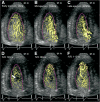Characterization and quantification of vortex flow in the human left ventricle by contrast echocardiography using vector particle image velocimetry
- PMID: 19356506
- PMCID: PMC4695212
- DOI: 10.1016/j.jcmg.2008.06.008
Characterization and quantification of vortex flow in the human left ventricle by contrast echocardiography using vector particle image velocimetry
Abstract
Objectives: The aims of this study were to: 1) assess the feasibility of left ventricular (LV) vortex flow analysis using contrast echocardiography (CE); and 2) characterize and quantify LV vortex flow in normal subjects and patients with LV systolic dysfunction.
Background: Vortices that form during LV filling have specific geometry and anatomical locations that are critical determinants of directed blood flow during ejection. Therefore, it is clinically relevant to assess the vortex flow patterns to better understand the LV function.
Methods: Twenty-five patients (10 normal and 15 patients with abnormal LV systolic function) underwent CE with intravenous contrast agent, Definity (Bristol-Myers Squibb Medical Imaging, Inc., North Billerica, Massachusetts). The velocity vector and vorticity were estimated by particle image velocimetry. Average vortex parameters including vortex depth, transverse position, length, width, and sphericity index were measured. Vortex pulsatility parameters including relative strength, vortex relative strength, and vortex pulsation correlation were also estimated.
Results: Vortex depth and vortex length were significantly lower in the abnormal LV function group (0.443 +/- 0.04 vs. 0.482 +/- 0.06, p < 0.05; 0.366 +/- 0.06 vs. 0.467 +/- 0.05, p < 0.01, respectively). Vortex width was greater (0.209 +/- 0.05 vs. 0.128 +/- 0.06, p < 0.01) and sphericity index was lower (1.86 +/- 0.5 vs. 3.66 +/- 0.6, p < 0.001) in the abnormal LV function group. Relative strength (1.13 +/- 0.4 vs. 2.10 +/- 0.8, p < 0.001), vortex relative strength (0.57 +/- 0.2 vs. 1.19 +/- 0.5, p < 0.001), and vortex pulsation correlation (0.63 +/- 0.2 vs. 1.31 +/- 0.5, p < 0.001) were significantly lower in the abnormal LV function group.
Conclusions: It was feasible to quantify LV vorticity arrangement by CE using particle image velocimetry in normal subjects and those with LV systolic dysfunction, and the vorticity imaging by CE may serve as a novel approach to depict vortex, the principal quantity to assess the flow structure.
Figures








References
-
- Wu JZ, Ma HY, Zhou MD. Vorticity and Vortex Dynamics. Springer-Verlag; Berlin-Heidelberg, Germany: 2006.
-
- Kim WY, Walker PG, Pedersen EM, et al. Left ventricular blood flow patterns in normal subjects: a quantitative analysis by three-dimensional mag netic resonance velocity mapping. J Am Coll Cardiol. 1995;26:224–38. - PubMed
-
- Pedrizzetti G, Domenichini F. Nature optimizes the swirling flow in the human left ventricle. Phys Rev Lett. 2005;95:108101. - PubMed
-
- Mohiaddin RH, Yang GZ, Kilner PJ. Visualization of flow by vector analysis of multidirectional cine MR velocity mapping. J Comput Assist Tomogr. 1994;18:383–92. - PubMed
-
- Cenedese A, Del Prete Z, Miozzi M, Querzoli G. A laboratory investigation of the flow in the left ventricle of the human heart with prosthetic, tilting-disk valves. Exp Fluid. 2005;39:322–35.
Publication types
MeSH terms
Substances
Grants and funding
LinkOut - more resources
Full Text Sources
Other Literature Sources
Medical

